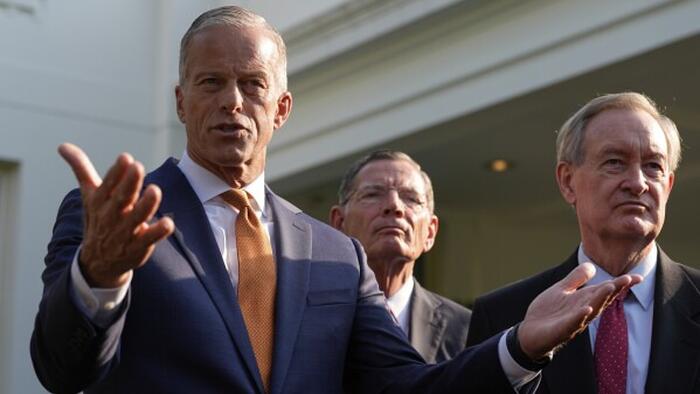


Senate Republicans on Monday unveiled the final and most contentious component of President Trump’s sweeping legislative package, the “Big, Beautiful Bill.” The Finance Committee’s long-awaited text - covering tax policy, Medicaid, and energy provisions - sets the stage for difficult negotiations between the Senate and the narrowly Republican-controlled House.
The Senate proposal scales back or reconfigures several measures passed by the House last month, particularly around health care funding and green energy. It also reveals stark policy divides that could derail GOP unity in the upper chamber.
A core pillar of the Senate’s bill is the permanent extension of key provisions from the 2017 tax overhaul. The legislation would lock in current federal tax brackets, boost the standard deduction, and continue the repeal of personal exemptions — all without expiration dates.
However, the Senate scaled back additional cuts proposed by House Republicans. Notably, the child tax credit would rise to $2,200 per child, short of the $2,500 outlined in the House bill.
The bill introduces targeted deductions for tipped workers, overtime earners, and car owners — a nod to priorities championed by President Trump during his re-election campaign. But the deductions are temporary and capped.
While the House bill sought broader relief, Senate Republicans opted for a more measured approach.
In a significant departure from the House version, the Senate bill aggressively targets Medicaid financing, particularly in states that expanded the program under the Affordable Care Act.
The legislation would reduce the allowable provider tax rate - a key funding mechanism for state Medicaid programs - from 6 percent to 3.5 percent by 2031. This reduction, phased in beginning in 2027, would apply only to expansion states.
Meanwhile, non-expansion states would be barred from introducing new provider taxes, though existing rates would be preserved. Nursing homes and intermediate care facilities are exempt from the cuts.
Unlike the House version, which protected existing hospital payment arrangements, the Senate bill eliminates some current state-directed payments altogether. The move drew immediate criticism from rural-state Republicans. Sen. Josh Hawley (R-Mo.), whose state relies heavily on provider taxes, expressed concern about the impact on hospitals.
Both chambers support requiring certain Medicaid recipients to meet work requirements, but the Senate version goes further. Adults with children over the age of 14 would now be required to work, attend school, or perform community service at least 80 hours a month.
The House version would exempt all parents of dependent children — a difference likely to stir debate during reconciliation talks.
The Senate’s approach to green energy tax credits appears less stringent than the House’s, though it still represents a rollback of the 2022 Inflation Reduction Act.
Under the Senate bill:
Unlike the House version, the Senate bill removes a requirement that projects produce electricity by 2028. It also extends eligibility to hydro, nuclear, and geothermal projects starting before 2034 — additions not included in the House’s text.
The Senate text would make permanent the existing $10,000 cap on state and local tax (SALT) deductions, a dramatic rollback of a compromise secured by Speaker Mike Johnson (R-La.) with blue-state Republicans to raise the cap to $40,000 for households earning under $500,000.
Majority Whip John Thune (R-S.D.) acknowledged that the $10,000 figure is a negotiation starting point. But House moderates are not budging.
“This proposal is DEAD ON ARRIVAL,” Rep. Mike Lawler (R-NY) posted on X, adding that "$40,000" is what was agreed upon after 'good faith negotiations.'
Perhaps the most contentious provision of all: the Senate bill would increase the debt ceiling by $5 trillion, surpassing the House’s proposed $4 trillion hike.
The move drew immediate opposition from fiscal conservatives. Sen. Rand Paul (R-KY) said he had informed Senate leadership he could not support the bill with the current debt ceiling language.
As Goldman Sachs notes, the Senate version of the “Section 899” provision to impose taxes on certain foreign individual, corporations, and governments makes four important changes from the House version:
- The application of higher US taxes would be delayed one year until the start of 2027.
- The same 5pp increase in tax rates but explicitly limit the total increase to 15pp after 3 years.
- The “portfolio interest exception” would exclude individual and corporate holders from increased tax withholding on interest payments.
- Small technical change that should result in the exclusion of foreign governments including central banks from interest withholding along with corporate and individual holders of US debt.
With the Senate bill now public, Republicans face an uphill climb in reconciling the two chambers’ positions. Deep ideological divisions remain on Medicaid reform, tax relief structure, and the scale of federal borrowing.
Negotiations are expected to intensify in the coming weeks as Republicans seek to deliver on Trump’s legislative priorities while avoiding a GOP family feud that could fracture the party ahead of November.
